The textile industry has always been at the forefront of cultural and technological change. From the industrial revolution’s spinning machines to today’s digital design software, fabrics have mirrored society’s evolving needs. In 2025, one name is steadily drawing attention in fashion and tech blogs alike: Chromtex. Positioned as the “next generation of smart, sustainable fabrics,” Chromtex claims to combine advanced textile engineering, nanotechnology, and eco-conscious production.
But what exactly is Chromtex? Why has it sparked so much discussion online? And what does it tell us about the future of clothing, design, and sustainability? This article explores the rise of Chromtex, its features, potential, challenges, and the wider context of smart textile innovation.
What Is Chromtex?
According to a cluster of fashion and lifestyle blogs, Chromtex is marketed as a revolutionary fabric that adapts, protects, and sustains. Descriptions highlight three major pillars:
-
Smart adaptability – textiles that respond to the wearer’s environment, movements, or body temperature.
-
Nanotechnology integration – microscopic structures woven into fibers to provide resistance, breathability, or even antibacterial properties.
-
Eco-friendly sustainability – promises of reduced waste, circular design principles, and greener production cycles.
So far, no official corporate website or whitepaper has detailed Chromtex’s technical specifications. Instead, its reputation largely comes from blog posts such as The Fashion Mag’s “Chromtex: The Next Generation of Smart and Sustainable Fabrics” and Urban Splatter’s “7 Revolutionary Ways This Fabric is Transforming Fashion.” These articles are enthusiastic but light on data, suggesting early-stage marketing buzz rather than fully verified product rollout.
The Broader Landscape of Smart Textiles
To appreciate Chromtex, it’s important to place it within the expanding field of smart textiles. Innovations over the past decade include:
-
Color-changing fabrics: For example, University of Central Florida’s ChroMorphous technology uses electrically activated pigments to alter fabric color.
-
Shape-morphing yarns: MIT’s FibeRobo fibers change form based on electrical signals, allowing clothes to tighten, loosen, or reshape.
-
Nanotech coatings: Fabrics infused with nanoparticles can repel water, resist stains, kill bacteria, or block harmful UV rays.
Chromtex’s reported qualities align closely with these developments. It positions itself not just as another high-performance textile but as a bridge between fashion-forward design and functional science.
Sustainability Claims
One of the strongest marketing points for Chromtex is its eco-friendly approach. Blogs emphasize:
-
Sustainable sourcing of fibers.
-
Circular programs, where worn-out garments could be collected and recycled.
-
Lower water and energy footprints during production.
However, without hard evidence such as GOTS (Global Organic Textile Standard) certification, OEKO-TEX® Standard 100, or ZDHC (Zero Discharge of Hazardous Chemicals) compliance, these remain claims rather than proven practices.
For comparison, established chemical suppliers like Chromatex Chemicals in Pakistan or India proudly display compliance documents for their dyes and auxiliaries. Chromtex, in contrast, has yet to publish such data. This gap is important for journalists, designers, and consumers to note.
Fashion & Design Potential
The excitement around Chromtex isn’t purely technical—it’s aesthetic. Imagine:
-
Activewear that adjusts breathability during workouts.
-
Streetwear that changes color in different lighting.
-
Luxury gowns that drape differently depending on room temperature.
-
Outdoor gear that remains lightweight yet withstands rain, snow, and UV rays.
For designers, this versatility offers endless possibilities. Chromtex could empower hyper-personalized fashion, where a single garment adapts to multiple contexts.
Market Hype vs. Reality
It’s worth asking: is Chromtex the real deal, or just clever branding?
Signs that it may be early hype:
-
Lack of technical data or patents.
-
Absence of an official Chromtex corporate site.
-
Overlapping confusion with similarly named companies (like Chromatex Chemicals or Chromatex Ink).
Signs that it may evolve into something real:
-
Growing interest from multiple blog outlets.
-
Alignment with genuine research trends in smart textiles.
-
Increasing consumer appetite for sustainable performance fabrics.
Until independent labs or universities release verifiable testing results, Chromtex remains a promising but unproven textile trend.
The Confusion Around Names: Chromtex vs. Chromatex
One challenge for researchers is the name similarity. Chromtex should not be confused with:
-
Chromatex Chemicals (Pakistan/India): suppliers of textile chemicals, auxiliaries, and finishing agents with compliance certifications.
-
Chromatex Ink (Canada): a manufacturer of screen-printing and DTF inks.
These are entirely separate businesses, though their established presence makes it easier for Chromtex hype to piggyback on online search results. Clarity is crucial to avoid misleading readers or buyers.
Future Possibilities of Chromtex
If Chromtex delivers on its promises, here’s what the future might hold:
-
Mainstream Fashion Integration – accessible clothing lines marketed as adaptive and eco-responsible.
-
Sports & Performance Wear – smart fabrics that optimize for sweat, temperature, and durability.
-
Medical Textiles – garments that monitor health, release therapeutic agents, or protect against infections.
-
Military & Outdoor Applications – fabrics that camouflage, self-repair, or protect in extreme environments.
In essence, Chromtex has the potential to blur the line between clothing and technology.
Why Chromtex Matters
Even if Chromtex itself turns out to be early marketing, the hype highlights three important truths about today’s fabric industry:
-
Consumers demand sustainability – Eco-friendly credentials are no longer optional.
-
Fashion is becoming functional – Style and performance increasingly merge.
-
Innovation storytelling drives adoption – Blogs and influencers are shaping perceptions before products are widely available.
Conclusion
Chromtex has been described as the textile that could transform fashion, sustainability, and smart wearables. While its potential is exciting, readers and designers should treat claims with cautious optimism until supported by certifications, patents, or technical studies. Whether Chromtex itself becomes the defining smart fabric of the decade or simply opens the door for more robust innovations, its story reflects the future direction of global textiles.
As we watch Chromtex evolve, one thing is certain: the fabric of tomorrow will be smarter, greener, and more responsive than anything we’ve seen before.
This article was published for readers of Tumblr Magazine, where technology and creativity intersect.







